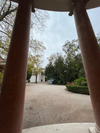A Case Study
The Potential of National Pavilions as Public Spaces: For Whom and About What? Amarildo Ajasse

The Venice Biennale national pavilion structure has often been criticized for its exclusivity and inability to change its own features.
What if the country of Germany by chance moved its geographical location? Would the relocated country continue to be called Germany? What if Germany had to find a new space for its national participation at the Venice Biennale every other year?


Imagination about such a shift characterized the German pavilion at the 55th Venice Biennale in 2013. For that edition, Germany switched national pavilions with France. In starting from this swap, the main goal is to examine and illustrate how the pavilion idea was challenged.However, new forms of national presentation are not always accepted without criticism or protest.
